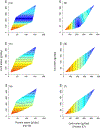The interaction of macronutrients and body composition among individuals with chronic spinal cord injury
- PMID: 35738897
- PMCID: PMC9789189
- DOI: 10.1017/S0007114522001830
The interaction of macronutrients and body composition among individuals with chronic spinal cord injury
Abstract
Changes in body composition and dietary intake occur following spinal cord injury (SCI). The Geometric Framework for Nutrition (GFN) is a tool that allows the examination of the complex relationships between multiple nutrition factors and health parameters within a single model. This study aimed to utilize the GFN to examine the associations between self-reported macronutrient intakes and body composition in persons with chronic SCI. Forty-eight individuals with chronic SCI were recruited. Participants completed and returned 3- or 5-day self-reported dietary recall sheets. Dietary intake of macronutrients (fats, proteins, and carbohydrates) were analysed. Anthropometric measures (circumferences), dual-energy x-ray absorptiometry (DXA), and magnetic resonance imaging (MRI) were used to assess whlole-body composition. Associations between all circumference measures and carbohydrates were observed. Among MRI measures, only significant associations between subcutaneous adipose tissue and protein x carbohydrate as well as carbohydrates alone were identified. Carbohydrates were negatively associated with several measures of fat mass as measured by DXA. Overall, carbohydrates appear to play an important role in body composition among individuals with SCI. Higher carbohydrate intake was associated with lower fat mass. Additional research is needed to determine how carbohydrate intake influences body composition and cardiometabolic health after SCI.
Keywords: Body composition; Carbohydrates; Geometric framework for nutrition; Macronutrients; Nutrition; Spinal cord injury.
Conflict of interest statement
The authors have no conflicts to report.
Figures




References
-
- Farkas GJ, Pitot MA, Berg AS, et al. (2019) Nutritional status in chronic spinal cord injury: a systematic review and meta-analysis. Spinal Cord 57, 3–17. - PubMed
-
- Bertoli S, Spadafranca A, Merati G, et al. (2008) Nutritional counselling in disabled people: effects on dietary patterns, body composition and cardiovascular risk factors. Eur J Phys Rehabil Med 44, 149–158. - PubMed
-
- Nightingale TE & Gorgey AS (2018) Predicting basal metabolic rate in men with motor complete spinal cord injury. Med Sci Sports Exerc 50, 1305–1312. - PubMed
Grants and funding
LinkOut - more resources
Full Text Sources

